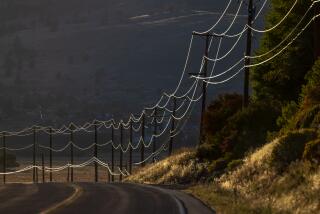Study Warns of Future Summer Blackouts
Hereâs a chilling thought as we enter the air-conditioner-hugging days of late summer: Californiaâs power grid is up to the challenge of this seasonâs blast of heat, but blackouts could threaten in future summers, according to a California Energy Commission staff report.
The study of high temperatures and electricity demand in California, nicknamed the âheat stormâ report by the Sacramento-based energy agency, casts doubt on whether the stateâs complex network of electricity-generating plants can churn out enough electrons if the record temperatures that scorched the West last summer were to repeat.
Thatâs because growth in California is increasing the demand for electricity by nearly 2% a year and new power plants that are expected to produce more than 7,000 megawatts of energy will not begin to operate until 2002 and later, the report stated.
While the hot weather of last summer was extremely unusual, occurring only once in 40 years, the projected growth in demand for electricity by 2004 would stress the power system to the same extent as last summerâs heat wave unless new power plants are built, the study said.
Such problems already afflict other regions of the country.
âI would not call it an uplifting report,â said Daniel Nix, deputy director of the California Energy Commission.
âBy the year 2001, things begin to look pretty iffy and more problematic because of increasing demandâ that could outstrip the marketâs ability to build new power plants, he said.
In the studyâs gloomiest forecast, Californiaâs power reserves would be thin enough within three years that extremely high temperatures--combined with power plant or transmission line outages and dry conditions in the Pacific Northwest that would reduce Californiaâs supply of cheap hydroelectric power--âcould seriously threaten system reliability,â the report said.
Under such a scenario, brownouts or rolling blackouts might be possible, Nix said.
âItâs certainly not a problem that we want to ignore,â Nix said.
Before Californiaâs $28-billion electricity market was restructured by landmark 1996 legislation, the stateâs investor-owned utilities built power plants under the direction of regulators to ensure the reliability of the grid.
Now, power plants will be built by developers looking to make a profit.
This new market places the burden of supply disruptions on consumers of electricity.
Some industrial users, for example, assume the risk of having their power interrupted when supplies are low in exchange for a rate discount.
Industry and government are searching for answers other than new power plants, Nix said, noting that U.S. Energy Secretary Bill Richardson recently called for new efficiency standards for air conditioners and other home appliances to reduce hot-weather demand.
More to Read
Inside the business of entertainment
The Wide Shot brings you news, analysis and insights on everything from streaming wars to production â and what it all means for the future.
You may occasionally receive promotional content from the Los Angeles Times.










